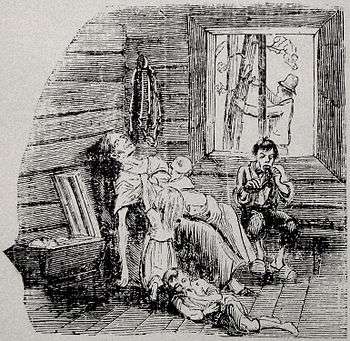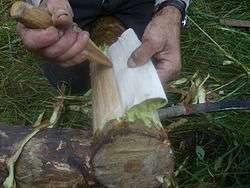Famine of 1866–68


The Famine of 1866–1868 was the last famine in Finland and Sweden, and the last major naturally caused famine in Europe. In Finland the famine is known as "the great hunger years", or suuret nälkävuodet. About 15% of the entire population died; in the hardest-hit areas up to 20%. The total death toll was 270,000 in three years, about 150,000 in excess of normal mortality. The worst-hit areas were Satakunta, Tavastia, Ostrobothnia, and North Karelia. In Sweden, the year 1867 was known as Storsvagåret (The Year of Great Weakness) and, in Tornedalen, as the Lavåret (The Lichen Year) because of the bark bread made of lichen.[1] It contributed to the great rush of the Swedish emigration to the United States.[1]
Finland
Causes
Parts of the country had suffered poor harvests in previous years, most notably in 1862. The summer of 1866 was extremely rainy, and staple crops failed widely: potatoes and root vegetables rotted in the fields, and conditions for sowing grain in the autumn were unfavourable. When stored food ran out, thousands took to the roads to beg. The following winter was hard, and spring was late. In Helsinki, the average temperature in May 1867 was +1.8 °C (35.2 °F), about 8 °C (14 °F) below the long-time average and by far the coldest such month in the meteorological record. In many places, lakes and rivers remained frozen until June. After a promisingly warm midsummer, freezing temperatures in early September ravaged crops; as a result, the harvest was about half the average. By the autumn of 1867, people were dying by the thousands.[2]
Actions
The government of the Grand Duchy of Finland was ill-equipped to handle a crisis of such magnitude. There was no money readily available to import food from largely monopolized Central European markets, and the government was slow to recognize the severity of the situation. Finance minister Johan Vilhelm Snellman, in particular, did not want to borrow, lest Finland's recently introduced currency, the Finnish markka, be weakened because of high interest rates. When money was finally borrowed from the Rothschild bank of Frankfurt in late 1867, the crisis was already full blown, and grain prices had risen in Europe. In addition, it was difficult to transport what little aid could be mustered in a country with poor communications. A number of emergency public works projects were set up, foremost among them the construction of the railway line from Riihimäki to Saint Petersburg.
Aftermath
The weather returned to normal in 1868, and that year's harvest was somewhat better than average, yet, contagious diseases that had spread in the previous year took many additional lives.
Programs were launched to increase the diversity of Finnish agriculture, and rapidly improving communications made a recurrence of such a famine less likely.
In general, ordinary Finns at the time saw the famine as an act of God. Few would have expected the crown to be able to do much more, and blame was directed mainly at local officials. No significant working class political movement had developed yet that could have capitalized politically on the crisis. The urban population was small, and for the people of the countryside, the first priority was to resume normal lives. In short, the famine did not threaten the social order, but its memory cast a long shadow.
Sweden
Causes
During the 1860s, Sweden had suffered poor harvests on several occasions. The spring and summer of 1867 was extremely cold all over Sweden.[1] In Burträsk, for example, it was not possible to start sowing before Midsummer: snow was still left in June. The late spring was followed by a very short summer and an early autumn. This caused not just bad harvests, but also made it difficult to feed the cattle. The consequence was rising food prices.[1] This caused widespread famine. The famine struck throughout Sweden, but was particularly severe in the Northern provinces. Because of early ice and snow disturbed communications, it was hard to transport and distribute emergency food supplies to the starving areas.[1] The year of 1868 was, in contrast to the previous year, not cold, but a widespread drought caused a failed harvest and starving animals nonetheless, which caused a continuation of the famine.
Actions

In the autumn of 1867, the government of Sweden granted emergency loans to the Northern counties, and the county governors were given permission and encouraged to establish undsättningskomitté (emergency committee) to collect the funds needed from volunteers and philanthropists.[1] Furthermore, two central emergency committees were created by the government: one located in the capital of Stockholm and the second in Gothenburg. The press published appeals for funds to help the needed, and charity concerts, charity plays and other similar events were hosted to collect money to pay for emergency help to the victims of the famine.[1] Funds from outside Sweden were also contributed both from Europe and America: in fact, the foreign contributions were reportedly about as large as those from inside the country. Among the contributors from outside Sweden was Jenny Lind, with a sum of 500 kronor, and John Ericsson with a sum of 20 000 kronor.[1]
The help from the emergency committees was distributed by the local city councils.[1] However, the help was restricted by regulations. The terms to receive help was not merely starvation: a starvation victim would have to be willing to work to receive help, otherwise they would not be given help. An exception was made for people who were physically unable to work, such as invalids and the elderly, but the regulations stipulated that only 10 percent of the emergency help was allowed to be spent on "charity", while the rest was only to be distributed to people willing to work in exchange.[1] Therefore, work such as road construction and home production of various form of handicraft objects were organized to give people in need of the emergency help an opportunity to work for it. In practice, these work tasks were meant as a symbolic demonstration that the government would only help those willing to work and be productive.[1]
The local city councils were criticized for enforcing the principle of help in exchange for work so far that the most needing were left without help. An example of this abuse occurred in the parish of Grundsunda kommun in Ångermanland, where no one who could not offer Surety was given help.[1] The local governor, Per Grundström, described in the distribution of help in the press: "A great mass of beggars and paupers could not be given anything. Torp are and other undesirables were in fact left without much at all."[1] The authorities recommended that the starving people should eat Bark bread made of lichen rather than expect great amounts of flour in relief help. Some of the local emergency committees, such as the one in Härnösand, mixed the flour with lichen and had it baked to bread before distributing it.[1] This bread, however, caused chest pains and, in children, vomiting.[1]
Aftermath

The authorities were exposed to harsh criticism from the press because of how ineffective the relief funds from the emergency committees was distributed, and on which terms. Especially the paper Fäderneslandet voiced anger against the fact that those most in need of help were left without because of the unwillingness of the authorities to compromise the principle of help in exchange for work, a regulation the paper described as "quasi philosophical thoughts about the value of work".[1]
There was a widespread criticism focused on the belief that the famine in Sweden was caused by unjust distribution.[1] This is supported by the fact that the year of 1867 was in fact a successful year for the Swedish Cereal-export: the largest of the farms and estates in Sweden exported their harvests, mostly oats, to Great Britain, where it was used for horse drawn buses in London.[1]
The great famine of 1867-68, and the distrust and discontent of the way the authorities handled the relief help to the needy, is estimated to have contributed greatly to the Swedish emigration to the United States, which skyrocketed around this time.
See also
References
- 1 2 3 4 5 6 7 8 9 10 11 12 13 14 15 16 17 18 Häger, Olle; Torell, Carl; Villius, Hans (1978). Ett satans år: Norrland 1867. Stockholm: Sveriges Radio. Libris 8358120. ISBN 91-522-1529-6 (inb.)
- ↑ Gershwin, M. Eric; German, J. Bruce; Keen, Carl L. (2000). Nutrition and immunology: principles and practice. Humana Press. p. 43. ISBN 0-89603-719-3.
